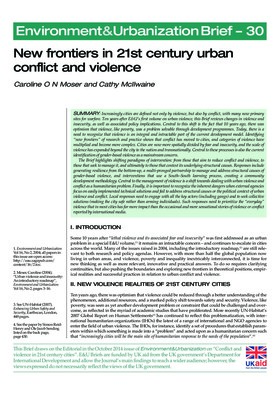New frontiers in 21st century urban conflict and violence

Increasingly cities are defined not only by violence, but also by conflict, with many now primary sites for warfare. Ten years after E&U’s first volume on urban violence, this Brief reviews changes in violence and insecurity, as well as associated policy implications. Central to this shift is the fact that 10 years ago, there was optimism that violence, like poverty, was a problem solvable through development programmes. Today, there is a need to recognize that violence is an integral and intractable part of the current development model. Identifying “new frontiers” of research and practice shows that conflict has moved to cities, and categories of violence have multiplied and become more complex. Cities are now more spatially divided by fear and insecurity, and the scale of violence has expanded beyond the city to the nation and transnationally. Central to these processes is also the current identification of gender-based violence as a mainstream concern.
The Brief highlights shifting paradigms of intervention: from those that aim to reduce conflict and violence, to those that seek to manage it, and ultimately to those that contest its underlying structural causes. Responses include generating resilience from the bottom-up, a multi-pronged partnership to manage and address structural causes of gender-based violence, and interventions that use a South–South learning process, creating a community development methodology. Central to the management of violence is a shift towards dealing with urban violence and conflict as a humanitarian problem. Responses need to prioritize the “everyday” violence that in most cities has far more impact than the occasional and more sensational stories of violence or conflict reported by international media.
Cite this publication
Available at https://www.iied.org/17276iied